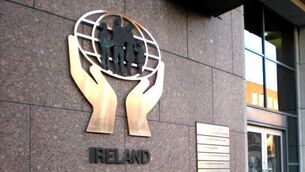European markets on edge as Trump tariffs on Canada and Mexico come into effect

US president Donald Trump speaks as C.C. Wei, chairman and CEO of Taiwan Semiconductor Manufacturing Company, and US Commerce Secretary Howard Lutnic kat the White House on Monday. (Pool via AP)
US president Donald Trump’s long-threatened tariffs against Canada and Mexico went into effect on Tuesday, putting global markets on edge and setting up costly retaliations by the United States’ North American allies. London market dropped sharply after heavy overnight falls on Wall Street after Mr Trump moved forward with planned tariffs against Canada and Mexico and doubled the levy on Chinese imports.
The FTSE 100 Index retreated from record highs notched up on Monday to drop more than 60 points at one stage after opening, later standing around 0.5% down at 8823.
Falls were also seen across Europe, with the Dax in Germany sinking 1.7%, while the Cac 40 in France was 1% down. In Dublin, the Iseq was down 0.7%.
After initially pausing the tariffs, Mr Trump said that starting just past midnight local time, imports from Canada and Mexico would now be taxed at 25%, with Canadian energy products receiving 10% tariffs.
In addition, the 10% tariff that Mr Trump placed on Chinese imports in February is doubling to 20%.
The move - which was followed swiftly by retaliatory action from Canada and China - sent US markets tumbling into the red, with the Dow Jones Industrial Average closing 1.5% lower and the S&P 500 ending the session down 1.8%.
In Asia, the Nikkei 225 dropped 1.2% but China's Hang Seng Index held largely firm, down 0.3%.
Starting just past midnight, imports from Canada and Mexico are now to be taxed at 25%, with Canadian energy products subject to 10% import duties.
The 10% tariff that Mr Trump Trump placed on Chinese imports in February was doubled to 20%, and Beijing retaliated Tuesday with tariffs of up to 15% on a wide array of U.S. farm exports. It also expanded the number of U.S. companies subject to export controls and other restrictions by about two dozen.
Canadian Prime Minister Justin Trudeau said his country would slap tariffs on more than $100bn (€95bn) of American goods over the course of 21 days. Mexico didn’t immediately detail any retaliatory measures.
Mr Trump’s moves raised fears of higher inflation and the prospect of a devastating trade war even as he promised the US public that taxes on imports are the easiest path to national prosperity. He has shown a willingness to buck the warnings of mainstream economists and put his own public approval on the line, believing that tariffs can fix what ails the country.
“It’s a very powerful weapon that politicians haven’t used because they were either dishonest, stupid or paid off in some other form,” Trump said Monday at the White House. “And now we’re using them.”
The Canada and Mexico tariffs were supposed to begin in February, but Mr Trump agreed to a 30-day suspension to negotiate further with the two largest US trading partners. The stated reason for the tariffs is to address drug trafficking and illegal immigration, and both countries say they’ve made progress on those issues. But Mr Trump has also said the tariffs will only come down if the US trade imbalance closes, a process unlikely to be settled on a political timeline.
The tariffs may be short-lived if the US economy suffers. But mr Trump could also impose more tariffs on the European Union, India, computer chips, autos and pharmaceutical drugs. The US president has injected a disorienting volatility into the world economy, leaving it off balance as people wonder what he’ll do next.
“It’s chaotic, especially compared to the way we saw tariffs rolled out in the first (Trump) administration,” said Michael House, co-chair of the international trade practice at the Perkins Coie law firm. “It’s unpredictable. We don’t know, in fact, what the president will do.’’
Democratic lawmakers were quick to criticise the tariffs, and even some Republican senators raised alarms. Senaor Susan Collins, R-Maine, said she’s “very concerned” about the tariffs going into effect because of her state’s proximity to Canada. “Maine and Canada’s economy are integrated,” Collins said, explaining that much of the state’s lobsters and blueberries are processed in Canada and then sent back to the US.
The world economy is now caught in the fog of what appears to be a trade war. Even after Trump announced Monday that the tariffs were going forward, Canadian officials were still in touch with their US counterparts.
“The dialogue will continue, but we are ready to respond,” Canadian Defence Minister Bill Blair said in Ottawa as he went into a special Cabinet meeting on US-Canada relations. “There are still discussions taking place.” Shortly after Mr Blair spoke, Mr Trudeau said Canada would impose 25% tariffs on more than €100bn worth of American goods, starting with tariffs on €20bn worth of goods immediately and on the remaining amount on US products in three weeks.
“Our tariffs will remain in place until the US trade action is withdrawn, and should US tariffs not cease, we are in active and ongoing discussions with provinces and territories to pursue several non-tariff measures,” Trudeau said.
The White House would like to see a drop in seizures of fentanyl inside the United States, not just on the northern and southern borders. Administration officials say that seizures of fentanyl last month in everywhere from Louisiana to New Jersey had ties to foreign cartels.
Damon Pike, technical practice leader for customs and trade services at the tax and consulting firm BDO, suggested the responses of other countries could escalate trade tensions and possibly increase the economic pressure points.
“Canada has their list ready,” Mr Pike said. “The EU has their list ready. It’s going to be tit for tat.’’
The Trump administration has suggested inflation will not be as bad as economists claim, saying tariffs can motivate foreign companies to open factories in the United States. On Monday, Trump announced that Taiwan Semiconductor Manufacturing Company, the computer chipmaker, would be investing $100bn in domestic production.
Still, it can take time to relocate factories spread across the world and train workers with the skills they need.
Greg Ahearn, president and CEO of The Toy Association, said the 20% tariffs on Chinese goods will be “crippling” for the toy industry, as nearly 80% of toys sold in the U.S. are made in China. “There’s a sophistication of manufacturing, of the tooling,” he said. “There’s a lot of handcrafting that is part of these toys that a lot of people don’t understand … the face painting, the face masks, the hair weaving, the hair braiding, the cut and sew for plush to get it to look just so. All of that are very high hands, skilled labor that has been passed through generations in the supply chain that exists with China.”
For a president who has promised quick results, Mr Ahearn added a note of caution about how quickly US factories could match their Chinese rivals. “That can’t be replicated overnight,” he said.
Associated Press, additional reporting by PA












